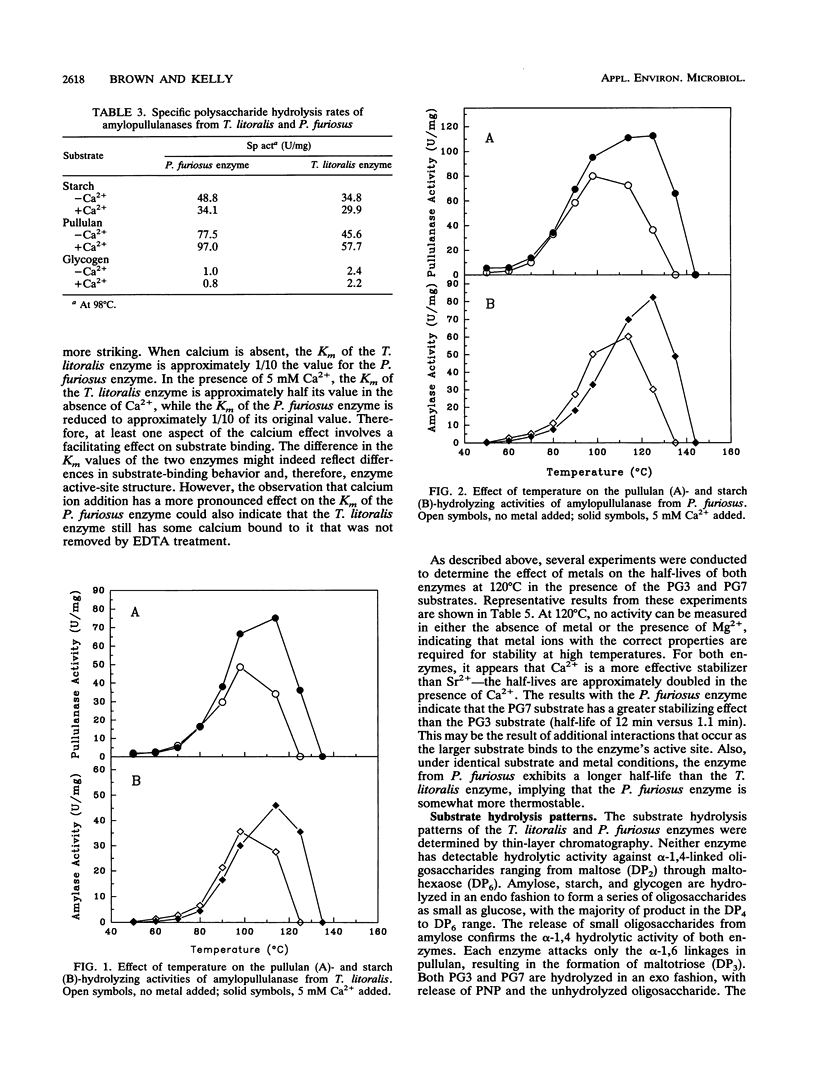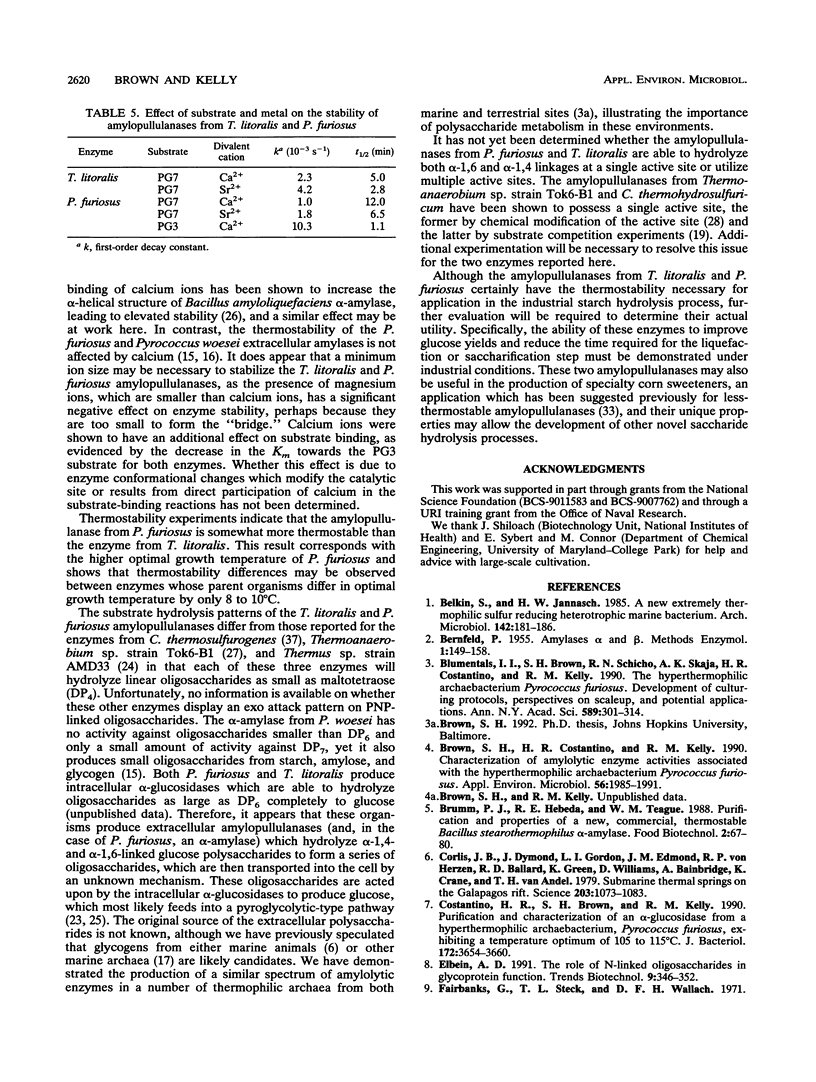Abstract
Extracellular pullulanases were purified from cell-free culture supernatants of the marine thermophilic archaea Thermococcus litoralis (optimal growth temperature, 90°C) and Pyrococcus furiosus (optimal growth temperature, 98°C). The molecular mass of the T. litoralis enzyme was estimated at 119,000 Da by electrophoresis, while the P. furiosus enzyme exhibited a molecular mass of 110,000 Da under the same conditions. Both enzymes tested positive for bound sugar by the periodic acid-Schiff technique and are therefore glycoproteins. The thermoactivity and thermostability of both enzymes were enhanced in the presence of 5 mM Ca2+, and under these conditions, enzyme activity could be measured at temperatures of up to 130 to 140°C. The addition of Ca2+ also affected substrate binding, as evidenced by a decrease in Km for both enzymes when assayed in the presence of this metal. Each of these enzymes was able to hydrolyze, in addition to the α-1,6 linkages in pullulan, α-1,4 linkages in amylose and soluble starch. Neither enzyme possessed activity against maltohexaose or other smaller α-1,4-linked oligosaccharides. The enzymes from T. litoralis and P. furiosus appear to represent highly thermostable amylopullulanases, versions of which have been isolated from less-thermophilic organisms. The identification of these enzymes further defines the saccharide-metabolizing systems possessed by these two organisms.
Full text
PDF







Selected References
These references are in PubMed. This may not be the complete list of references from this article.
- Blumentals I. I., Brown S. H., Schicho R. N., Skaja A. K., Costantino H. R., Kelly R. M. The hyperthermophilic archaebacterium, Pyrococcus furiosus. Development of culturing protocols, perspectives on scaleup, and potential applications. Ann N Y Acad Sci. 1990;589:301–314. doi: 10.1111/j.1749-6632.1990.tb24254.x. [DOI] [PubMed] [Google Scholar]
- Brown S. H., Costantino H. R., Kelly R. M. Characterization of Amylolytic Enzyme Activities Associated with the Hyperthermophilic Archaebacterium Pyrococcus furiosus. Appl Environ Microbiol. 1990 Jul;56(7):1985–1991. doi: 10.1128/aem.56.7.1985-1991.1990. [DOI] [PMC free article] [PubMed] [Google Scholar]
- Corliss J. B., Dymond J., Gordon L. I., Edmond J. M., von Herzen R. P., Ballard R. D., Green K., Williams D., Bainbridge A., Crane K., van Andel T. H. Submarine thermal sprirngs on the galapagos rift. Science. 1979 Mar 16;203(4385):1073–1083. doi: 10.1126/science.203.4385.1073. [DOI] [PubMed] [Google Scholar]
- Costantino H. R., Brown S. H., Kelly R. M. Purification and characterization of an alpha-glucosidase from a hyperthermophilic archaebacterium, Pyrococcus furiosus, exhibiting a temperature optimum of 105 to 115 degrees C. J Bacteriol. 1990 Jul;172(7):3654–3660. doi: 10.1128/jb.172.7.3654-3660.1990. [DOI] [PMC free article] [PubMed] [Google Scholar]
- Elbein A. D. The role of N-linked oligosaccharides in glycoprotein function. Trends Biotechnol. 1991 Oct;9(10):346–352. doi: 10.1016/0167-7799(91)90117-z. [DOI] [PubMed] [Google Scholar]
- Fairbanks G., Steck T. L., Wallach D. F. Electrophoretic analysis of the major polypeptides of the human erythrocyte membrane. Biochemistry. 1971 Jun 22;10(13):2606–2617. doi: 10.1021/bi00789a030. [DOI] [PubMed] [Google Scholar]
- Laemmli U. K. Cleavage of structural proteins during the assembly of the head of bacteriophage T4. Nature. 1970 Aug 15;227(5259):680–685. doi: 10.1038/227680a0. [DOI] [PubMed] [Google Scholar]
- Mathupala S., Saha B. C., Zeikus J. G. Substrate competition and specificity at the active site of amylopullulanase from Clostridium thermohydrosulfuricum. Biochem Biophys Res Commun. 1990 Jan 15;166(1):126–132. doi: 10.1016/0006-291x(90)91920-n. [DOI] [PubMed] [Google Scholar]
- Melasniemi H. Characterization of alpha-amylase and pullulanase activities of Clostridium thermohydrosulfuricum. Evidence for a novel thermostable amylase. Biochem J. 1987 Aug 15;246(1):193–197. doi: 10.1042/bj2460193. [DOI] [PMC free article] [PubMed] [Google Scholar]
- Melasniemi H. Purification and some properties of the extracellular alpha-amylase-pullulanase produced by Clostridium thermohydrosulfuricum. Biochem J. 1988 Mar 15;250(3):813–818. doi: 10.1042/bj2500813. [DOI] [PMC free article] [PubMed] [Google Scholar]
- Mukund S., Adams M. W. The novel tungsten-iron-sulfur protein of the hyperthermophilic archaebacterium, Pyrococcus furiosus, is an aldehyde ferredoxin oxidoreductase. Evidence for its participation in a unique glycolytic pathway. J Biol Chem. 1991 Aug 5;266(22):14208–14216. [PubMed] [Google Scholar]
- Plant A. R., Clemens R. M., Morgan H. W., Daniel R. M. Active-site- and substrate-specificity of Thermoanaerobium Tok6-B1 pullulanase. Biochem J. 1987 Sep 1;246(2):537–541. doi: 10.1042/bj2460537. [DOI] [PMC free article] [PubMed] [Google Scholar]
- Saha B. C., Lamed R., Lee C. Y., Mathupala S. P., Zeikus J. G. Characterization of an endo-Acting Amylopullulanase from Thermoanaerobacter Strain B6A. Appl Environ Microbiol. 1990 Apr;56(4):881–886. doi: 10.1128/aem.56.4.881-886.1990. [DOI] [PMC free article] [PubMed] [Google Scholar]
- Saha B. C., Mathupala S. P., Zeikus J. G. Purification and characterization of a highly thermostable novel pullulanase from Clostridium thermohydrosulfuricum. Biochem J. 1988 Jun 1;252(2):343–348. doi: 10.1042/bj2520343. [DOI] [PMC free article] [PubMed] [Google Scholar]
- Shively E. H., Wieman T. J., Adams A. L., Romines R. B., Garrison R. N. Operative cholangiography. Am J Surg. 1990 Apr;159(4):380–385. doi: 10.1016/s0002-9610(05)81276-0. [DOI] [PubMed] [Google Scholar]


